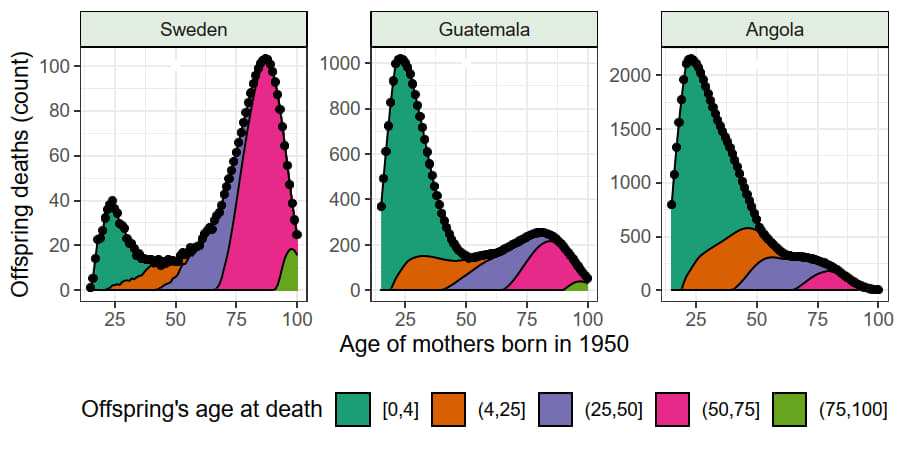Laboratory
Population Dynamics and Sustainable Well-Being
At a Glance
Projects
Publications
Team
Project
Demographic Perspectives on Kin Availability and Kin Loss
Ugofilippo Basellini, Diego Alburez-Gutierrez, Emilio Zagheni, Carolina Coimbra Vieira, Liliana P. Calderón-Bernal, Mallika Snyder (University of California, Berkeley, USA), Ivan Williams (University of Buenos Aires, Argentina)
Detailed Description
The study of family structures has a long tradition in demography. Early formal demographic work aimed to determine the degree to which population change influences kinship networks. Yet, the implementation of demographic models for early kinship was hampered by limited data availability and restricted computational power. The same was true of subsequent work that used demographic microsimulation to model kinship structures. Meanwhile, the question of how kinship networks are structured has gained further relevance in the context of rapid and global family change.
The degree to which individuals have access to kinship resources varies greatly. Whereas some countries experience fast population aging and demographic decline, others continue to show high levels of fertility and mortality. These dynamics produce heterogeneous kinship structures. For example, in low-mortality settings, individuals can expect to have fewer siblings; older members of these populations are also at a higher risk of being kinless when they are old (i.e., not having access to any form of kinship resource). In countries of high fertility and high mortality, individuals are more likely to be exposed to kin loss, which is known to have detrimental consequences for bereaved relatives. Kin availability and kin loss are both predictable properties of populations that result from present and past demographic dynamics.
We study how demographic change affects the availability of kinship resources throughout the life course and the exposure to kin loss within the family either through mortality of relatives or other ways in which kin may be "lost" (e.g., disappeared persons, family dissolution, migration). We develop new measures to quantify population-level inequalities in kin availability and kin mortality under different demographic regimes. Methods for estimating shared lifetimes between different kin types across time and over the life course, for example, are particularly needed in low-income settings where traditional analyses cannot be done given the inadequacy of existing data for direct estimation. Measures of the frequency and timing of losses in the family matter because these events have long-lasting negative effects for bereaved relatives, as empirical research has shown. But we lack a clear understanding of the demographic dynamics underlying this phenomenon. The project also explores the potential of using novel data sources (e.g., crowd-sourced online genealogies and social media data) and innovative approaches (e.g., demographic microsimulation) to quantify kinship dynamics in populations around the world.
Our research has produced important insights into kinship dynamics. For example, one of our studies has shown that the experience of losing a child is considerably more common in countries of the Global South, given that this region has high mortality levels but also a legacy of high fertility. Another one of our studies has shown how excess mortality from COVID-19 interacted with preexisting kinship structures to produce distinct generational patterns of kin loss. The importance of demographic legacies was also highlighted in a study of ours on generational overlap. We have found that the Sandwich Generation (individuals who have both younger and older dependent relatives) is less prevalent than expected for the aging populations of Europe and North America.
Expected number of offspring deaths over the maternal life course for women born in 1950 in three selected countries

Expected number of offspring deaths over the maternal life course for women born in 1950 in three selected countries (black dots, population-level non-cumulative counts). The colored areas show the offspring´s age at death. Offspring loss is concentrated at older ages in Sweden but affects younger mothers in Guatemala and Angola (note the different y-axes in each panel). © Alburez-Gutierrez, D.; Basellini, U.; Zagheni, E.: When do parents bury a child? Quantifying uncertainty in the parental age at offspring loss MPIDR Working Paper WP-2022-016. (2022)
Aging, Mortality and Longevity, Demographic Change, Historical Demography, Intergenerational Relationships, Life Course
Publications
Alburez-Gutierrez, D.; Basellini, U.; Zagheni, E.:
Population Studies 79:1, 45–57. (2025)

Calderón-Bernal, L. P.; Alburez-Gutierrez, D.; Zagheni, E.:
MPIDR Working Paper WP-2023-034. (2023)

Alburez-Gutierrez, D.; Basellini, U.; Zagheni, E.:
MPIDR Working Paper WP-2022-016. (2022)

Chong, M.; Alburez-Gutierrez, D.; Alexander, M. J.; Zagheni, E.:
MPIDR Working Paper WP-2022-005. (2022)

Coimbra Vieira, C.; Alburez-Gutierrez, D.; Nepomuceno, M. R.; Theile, T.:
In: WebSci '22: proceedings of the 14th ACM Web Science Conference, Barcelona, Spain, 26-29 June 2022, 185–190. New York: Association for Computing Machinery (ACM). (2022)

Snyder, M.; Alburez-Gutierrez, D.; Williams, I.; Zagheni, E.:
Proceedings of the National Academy of Sciences of the United States of America 119:26, e2202686119–e2202686119. (2022)

Stelter, R.; Alburez-Gutierrez, D.:
Proceedings of the National Academy of Sciences of the United States of America 119:10, e2120455119–e2120455119. (2022)

Alburez-Gutierrez, D.; Kolk, M.; Zagheni, E.:
Demography 58:5, 1715–1735. (2021)

Alburez-Gutierrez, D.; Mason, C.; Zagheni, E.:
Population and Development Review 47:4, 997–1023. (2021)

Smith-Greenaway, E.; Alburez-Gutierrez, D.; Trinitapoli, J.; Zagheni, E.:
BMJ Global Health 6:4, e004837–e004837. (2021)

Williams, I.; Alburez-Gutierrez, D.:
MPIDR Working Paper WP-2021-001. (2021)

Williams, I.; Alburez-Gutierrez, D.; Song, X.; Caswell, H.:
Software. https://cran.r-project.org/web/packages/DemoKin/: CRAN. unpublished. (2021)